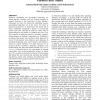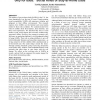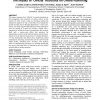CSCW
2016
ACM
8 years 11 months ago
2016
ACM
Online crowds are a promising source of new innovations. However, crowd innovation quality does not always match its quantity. In this paper, we explore how to improve crowd innov...
CSCW
2016
ACM
8 years 11 months ago
2016
ACM
Extensive scholarship has investigated technology use among families. Existing work has focused primarily on parents’ reactions to and restrictions of their children’s technol...
CSCW
2016
ACM
8 years 11 months ago
2016
ACM
We identify emerging phenomena of distributed liveness, involving new relationships among performers, audiences, and technology. Liveness is a recent, technology-based construct, ...
CSCW
2016
ACM
8 years 11 months ago
2016
ACM
The number of stay-at-home dads (SAHDs) in the U.S. has risen dramatically over the past 30 years. Despite gaining social acceptability, SAHDs still experience isolation and judgm...
CSCW
2016
ACM
8 years 11 months ago
2016
ACM
High-risk outdoor recreation allows its enthusiasts to reach unprecedented levels of adrenaline; it also contains risks and requires specific training (in part technological). In ...
CSCW
2016
ACM
8 years 11 months ago
2016
ACM
Research on newcomer roles in peer production sites (e.g., Wikipedia) is characterized by a broad and relatively wellarticulated set of functionally and culturally recognizable ro...
CSCW
2016
ACM
8 years 11 months ago
2016
ACM
CSCW
2016
ACM
8 years 11 months ago
2016
ACM
Expert feedback is valuable but hard to obtain for many designers. Online crowds can provide fast and affordable feedback, but workers may lack relevant domain knowledge and exper...
CSCW
2016
ACM
8 years 11 months ago
2016
ACM
Attending and presenting at conferences is a core part of academic and industrial research. Yet it can sometimes be challenging to attend conferences due to travel restrictions, t...
CSCW
2016
ACM
8 years 11 months ago
2016
ACM
We present the development and evaluation of a situated crowdsourcing mechanism that estimates queue length in real time. The system relies on public interactive kiosks to collect...



